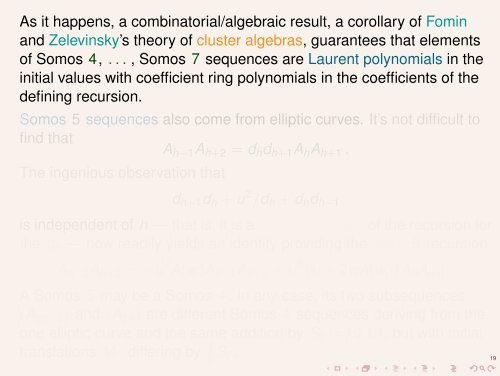Hyperelliptic Curves, Continued Fractions and Somos Sequences
Hyperelliptic Curves, Continued Fractions and Somos Sequences
Hyperelliptic Curves, Continued Fractions and Somos Sequences
You also want an ePaper? Increase the reach of your titles
YUMPU automatically turns print PDFs into web optimized ePapers that Google loves.
As it happens, a combinatorial/algebraic result, a corollary of Fomin<br />
<strong>and</strong> Zelevinsky’s theory of cluster algebras, guarantees that elements<br />
of <strong>Somos</strong> 4, . . . , <strong>Somos</strong> 7 sequences are Laurent polynomials in the<br />
initial values with coefficient ring polynomials in the coefficients of the<br />
defining recursion.<br />
<strong>Somos</strong> 5 sequences also come from elliptic curves. It’s not difficult to<br />
find that<br />
Ah−1Ah+2 = dhdh+1AhAh+1 .<br />
The ingenious observation that<br />
dh+1dh + u 2 /dh + dhdh−1<br />
is independent of h — that is, it is a discrete integral of the recursion for<br />
the dh — now readily yields an identity providing the width 5 recursion<br />
Ah−2Ah+3 = −u 2 A(w)Ah−1Ah+2 + u 3` u + 2wA(w) ´ AhAh+1.<br />
A <strong>Somos</strong> 5 may be a <strong>Somos</strong> 4. In any case, its two subsequences<br />
(A2h+1) <strong>and</strong> (A2h) are different <strong>Somos</strong> 4 sequences deriving from the<br />
one elliptic curve <strong>and</strong> the same addition by SE = (0, 0), but with initial<br />
translations ME differing by 1<br />
2 SE .<br />
19
















